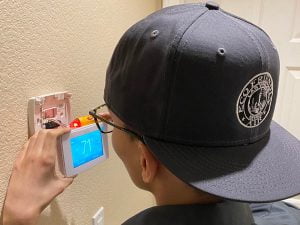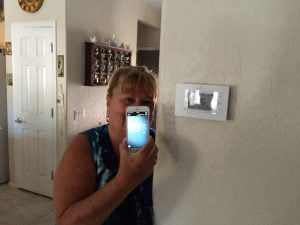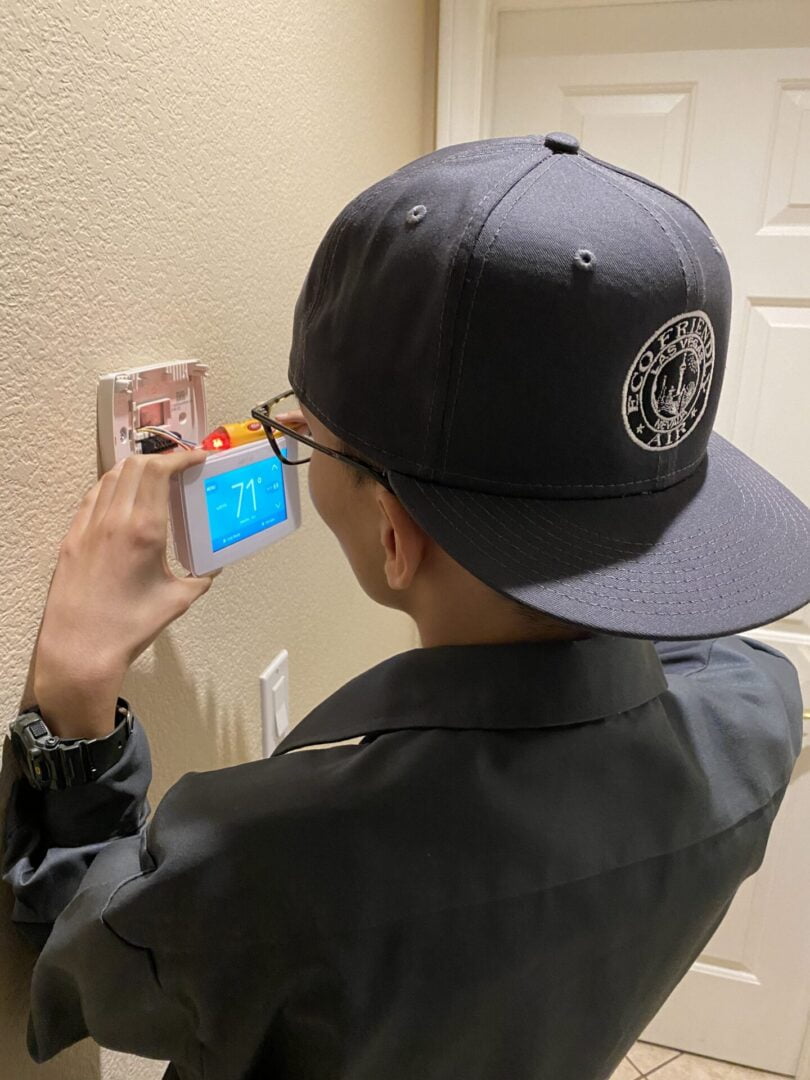Install Thermostat
You can save money on your heating and cooling bills by simply resetting your thermostat when you are asleep or away from home. You can do this automatically without sacrificing comfort by installing an automatic setback or programmable thermostat.
Using a programmable thermostat, you can adjust the times you turn on the heating or air-conditioning according to a pre-set schedule. Programmable thermostats can store and repeat multiple daily settings (six or more temperature settings a day) that you can manually override without affecting the rest of the daily or weekly program.

Thermostat Operation
You can save as much as 10% a year on heating and cooling by simply turning your thermostat back 7°-10°F for 8 hours a day from its normal setting. The percentage of savings from setback is greater for buildings in milder climates than for those in more severe climates.
The smaller the difference between the indoor and outdoor temperatures, the lower your overall cooling bill will be. You can easily save energy in the winter by setting the thermostat to around 68°F to 70°F while you’re awake and setting it lower while you’re asleep or away from home.
In the summer, you can follow the same strategy with central air conditioning by keeping your house warmer than normal when you are away, and setting the thermostat to a setting as high as is comfortable for you when you are at home and need cooling and to ensure humidity control if needed.
Although thermostats can be adjusted manually, programmable thermostats will avoid any discomfort by returning temperatures to normal before you wake or return home.
Avoid setting your thermostat at a colder setting than normal when you turn on your air conditioner. It will not cool your home any faster and could result in excessive cooling and, therefore, unnecessary expense.
A common misconception associated with thermostats is that a furnace works harder than normal to warm the space back to a comfortable temperature after the thermostat has been set back, resulting in little or no savings. In fact, as soon as your house drops below its normal temperature, it will lose energy to the surrounding environment more slowly.
During winter, the lower the interior temperature, the slower the heat loss. So the longer your house remains at the lower temperature, the more energy you save, because your house has lost less energy than it would have at the higher temperature.
The same concept applies to raising your thermostat setting in the summer — a higher interior temperature will slow the flow of heat into your house, saving energy on air conditioning. Check out our home heating infographic to learn more about how heating systems and thermostats interact. Schedule Now
Limitations for Homes with Heat Pumps, Electric Resistance Heating, Steam Heat, and Radiant Floor Heating
Programmable thermostats are generally not recommended for heat pumps. In its cooling mode, a heat pump operates like an air conditioner, so turning up the thermostat (either manually or with a programmable thermostat) will save energy and money. But when a heat pump is in its heating mode, setting back its thermostat can cause the unit to operate inefficiently, thereby canceling out any savings achieved by lowering the temperature setting. Maintaining a moderate setting is the most cost-effective practice. Recently, however, some companies have begun selling specially designed programmable thermostats for heat pumps, which make setting back the thermostat cost-effective. These thermostats typically use special algorithms to minimize the use of backup electric resistance heat systems. Schedule Now
Electric resistance systems, such as electric baseboard heating, require thermostats capable of directly controlling 120-volt or 240-volt circuits. Only a few companies manufacture line-voltage programmable thermostats.
The slow response time — up to several hours — of steam heating and radiant floor heating systems leads some people to suggest that setback is inappropriate for these systems. However, some manufacturers now offer thermostats that track the performance of your heating system to determine when to turn it on in order to achieve comfortable temperatures at your programmed time.
Alternately, a normal programmable thermostat can be set to begin its cool down well before you leave or go to bed and return to its regular temperature two or three hours before you wake up or return home. This may require some guesswork at first, but with a little trial and error you can still save energy while maintaining a comfortable home. Schedule Now

Choosing and Programming a Programmable Thermostat
Most programmable thermostats are either digital, electromechanical, or some mixture of the two. Digital thermostats offer the most features in terms of multiple setback settings, overrides, and adjustments for daylight savings time, but may be difficult for some people to program. Electromechanical systems often involve pegs or sliding bars and are relatively simple to program.
When programming your thermostat, consider when you normally go to sleep and wake up. If you prefer to sleep at a cooler temperature during the winter, you might want to start the temperature setback a bit ahead of the time you actually go to bed. Also consider the schedules of everyone in the household. If there is a time during the day when the house is unoccupied for four hours or more, it makes sense to adjust the temperature during those periods.

Why ENERGY STAR?
A smart thermostat is a Wi-Fi enabled device that automatically adjusts heating and cooling temperature settings in your home for optimal performance.
Smart thermostats that earn the ENERGY STAR label have been independently certified, based on actual field data, to deliver energy savings.
While system designs may vary, common smart thermostat features include:
Convenience
- Many smart thermostats learn your temperature preferences and establish a schedule that automatically adjusts to energy-saving temperatures when you are asleep or away.
- Geofencing allows your smart thermostat to know when you’re on the way home and automatically adjusts your home’s temperature to your liking.
Control
- Wi-Fi enabled thermostats allow you to control your home’s heating and cooling remotely through your smartphone.
- ENERGY STAR certified smart thermostats quickly enter a low-power standby mode when inactive.
Insight
- Smart thermostats provide equipment use and temperature data you can track and manage.
- Periodic software updates ensure your smart thermostat is using the latest algorithms and energy-saving features available. Learn more
Other Considerations
The location of your thermostat can affect its performance and efficiency. Read the manufacturer’s installation instructions to prevent “ghost readings” or unnecessary furnace or air conditioner cycling. To operate properly, a thermostat must be on an interior wall away from direct sunlight, drafts, doorways, skylights, and windows. It should be located where natural room air currents–warm air rising, cool air sinking–occur. Furniture will block natural air movement, so do not place pieces in front of or below your thermostat. Also make sure your thermostat is conveniently located for programming.
In the cold winter months it can be tempting to leave the thermostat at a set temperature when away so that when returning home it is warm. The attraction is not only the immediate gratification of a warm home, but many assume this practice saves energy because the heater won’t have to work as hard to heat the room to the desired temperature. Unfortunately, this is not true. It’s actually more efficient to heat your home as needed, which means turning the heat down when leaving the house, or setting a smart or programmable thermostat to do so, if you have one. It is possible to save as much as 10% on your heating bills by turning your thermostat back for eight hours during the day – typically when you are at work and not at home, or when you are sleeping at night. Schedule Now
Thermostat Placement
The right thermostat location is key to keeping you comfier and saving money on energy costs. Most important, avoid placing the thermostat in areas that can have temperature extremes. This can making the thermostat think that the room is a lot cooler or warmer than it actually is. For example, don’t install your thermostat near;
- doors that could let in drafts
- windows that could shine hot rays of sun onto the thermostat
- a bathroom door that could let hot steam settle around the thermostat
- Lamps or TV sets since they release heat that could confuse the device’s sensors.
- Schedule Now
For the best results, put your thermostat on an interior wall. Exterior walls are a non-starter because they are often closer to the temperature outside than other walls in the home. This will make the thermostat will think that this unusually cold or hot area represents the rest of the home and will kick on to cool or heat when it really doesn’t need to.
It is also important to be certain to place the thermostat in a well trafficked area. Putting a thermostat in a room or hallway that is rarely used isn’t a great idea because the thermostat won’t be reading the temperature of the area needing to be heated or cooled. Another option to consider is using a smart thermostat that works with remote wireless sensors that are able to be placed throughout the home. With these sensors the smart thermostat is able to adjust temperatures based on any room in the house. Schedule Now
Make certain a smart thermostat it is unobstructed by doors, bookshelves or decorations so that its sensors can work properly. Also, make sure that a smart thermostat is placed in range of the Wi-Fi source so that it can stay connected to the internet. As always, consult an HVAC professional if you have questions about your home’s wiring.

Schedule Now












